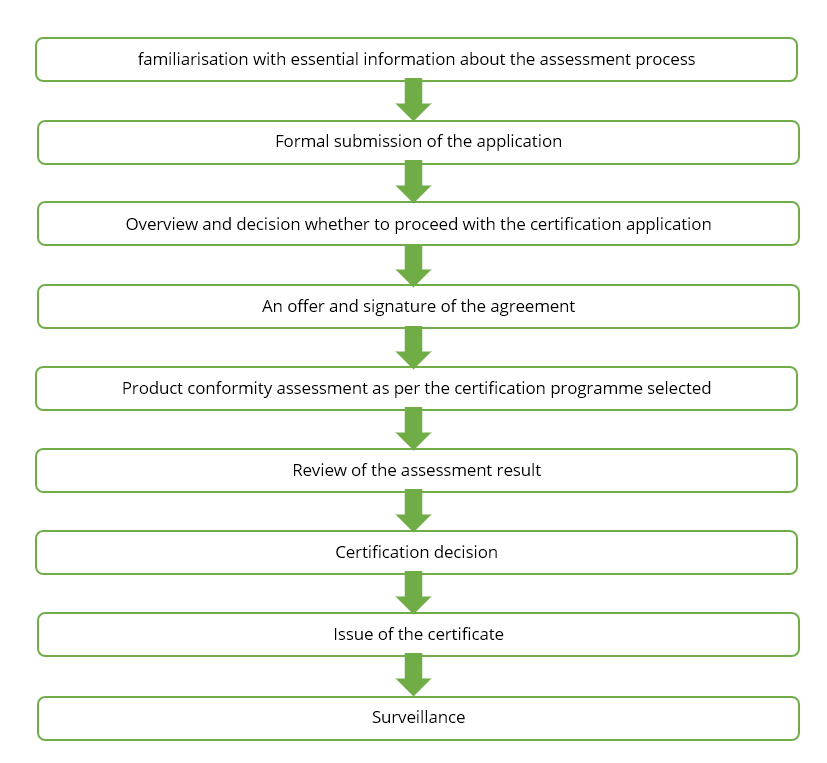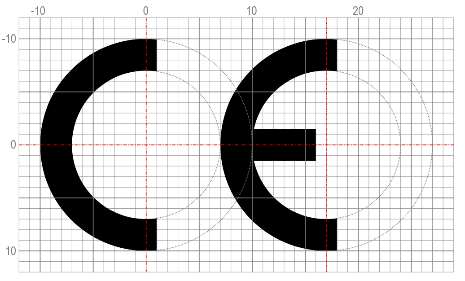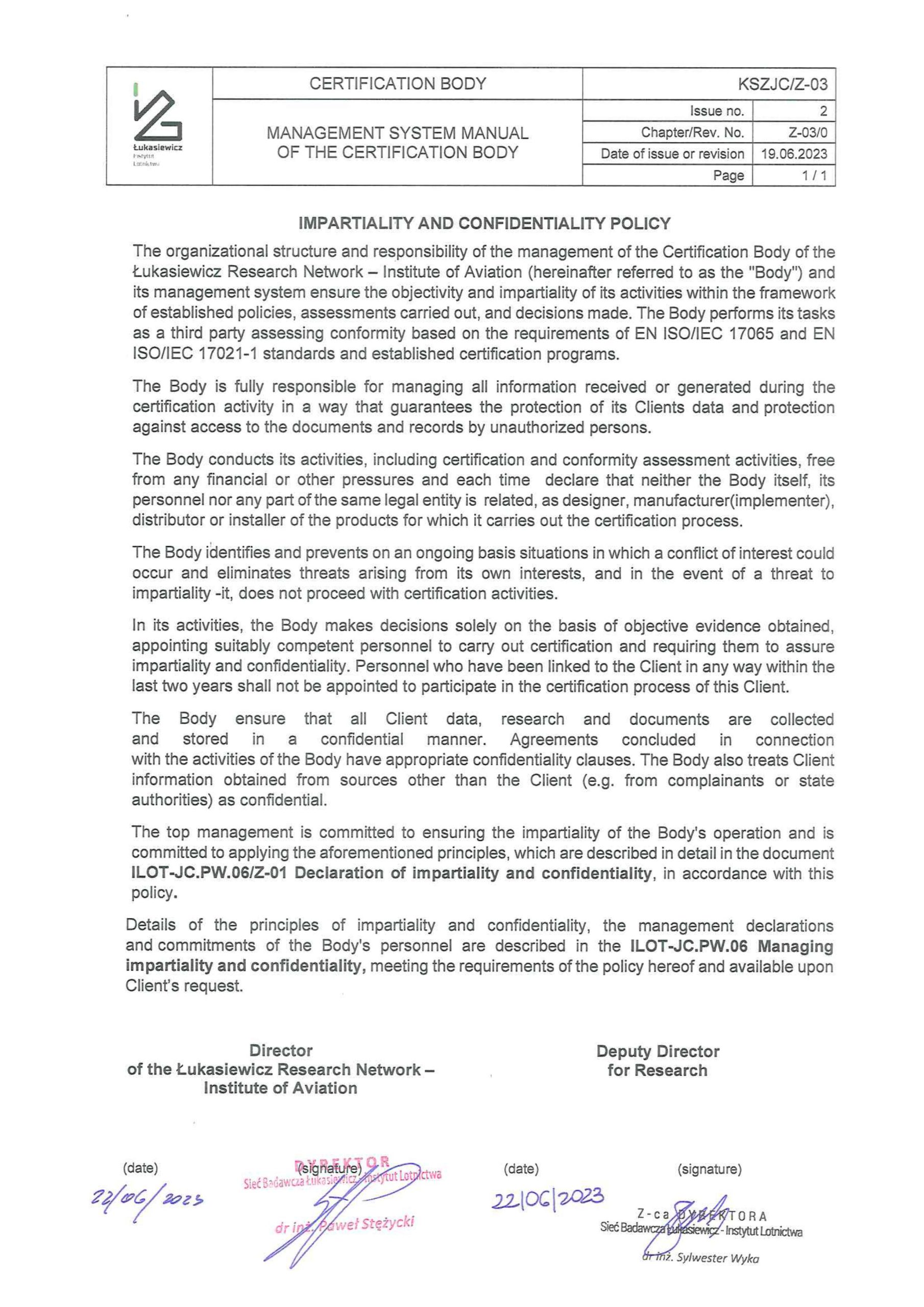Certification Body
ABOUT US
The Certification Body is an organisational unit of Łukasiewicz Research Network – Institute of Aviation. Building on its experience in unmanned aircraft as well as expertise and laboratory facilities with lab infrastructure within Łukasiewicz Research Network – Institute of Aviation, the Certification Body carries out accredited, notified and non-accredited certification activities concerning products subject to UAS certification programmes.OFFER
CERTIFICATION PROCEDURE
The Certification Body certifies unmanned aircraft systems (UAS) in terms of compliance with the requirements of Commission Delegated Regulation (EU) 2019/945 of 12 March 2019 on unmanned aircraft systems and on third-country operators of unmanned aircraft systems (Official Journal of the EU L 152 of 11.6.2019, as amended). UAS certification is based on the following certification programmes:- ILOT-JC.PG.01/P-01 Certification Programme ILOT-01 Conformity Assessment – Module B – EU-type examination
- ILOT-JC.PG.01/P-02 Certification Programme ILOT-02 Conformity Assessment – Module H – Conformity based on full quality assurance
Certification process diagram

Primary elements of the assessment of UAS conformity with the requirements laid down in Regulation 2019/945 within Certification Programme ILOT-01 Conformity Assessment – Module B – EU-type examination:
- planning and preparation of an assessment, examination of the documentation, examination of a specimen,
- assessment of the product properties through examination, inspection, assessment of the design,
- review and assessment of the evidence obtained in the course of b),
- a certification decision and issuance of relevant certification documents (a certificate of indefinite validity), where applicable,
- surveillance as per the relevant programme (including as a result of market signals, changes in the design, changes in the requirements, commissioning of a new production line, a new location etc.).
The basic elements of the assessment of the conformity of UAS with the requirements of Regulation 2019/945 under Certification Programme ILOT-02 Conformity Assessment – Module H – Conformity based on full quality assurance:
- planning and preparation of an audit/audits, examination of the technical documentation of the product, examination of the documentation of the quality system for design, manufacture, final inspection and testing of the product concerned,
- assessment of the capacity to manufacture a product that meets the requirements on the basis of the quality system operated (audits),
- review and assessment of the evidence obtained in the course of b),
- a certification decision and issuance of certification documents with validity of 3 years, where applicable,
- arrangements regarding scheduled surveillance audits (2 surveillance audits during the 3-year certification cycle),
- arrangements regarding re-certification (for another 3-year cycle).
QUALITY POLICY AND IMPARTIALITY AND CONFIDENTIALITY POLICY
Quality Policy
The Impartiality and Confidentiality Policy
HANDLING OF APPEALS AND COMPLAINTS
In the process of handling appeals and complaints, i.e. receiving, processing and decision-making, the requirements of confidentiality and impartiality are taken into account.
No discriminatory action is taken against any person submitting a complaint or appeal, nor against the Body’s Client.
The claim may be submitted by the Client or another party:
- in writing to the address: Certification Body Łukasiewicz Research Network – Institute of Aviation al. Krakowska 110/114 02-256 Warsaw or via e-mail to cert@ilot.lukasiewicz.gov.pl,
- by phone at +48 573 103 839,
- in person by appointment.
Appeals and complaints are considered by the Director of Łukasiewicz Research Network–Institute of Aviation in accordance with the procedure established in the Institute, provided that they concern certification activities for which the Body is responsible. Appeals and complaints which do not concern certification activities for which the Body is responsible are not considered, which communicated in writing to the party lodging an appeal/complaint.
Considering appeals and complaints the Body follows the Quality Polish and the Impartiality Policy, ensuring that there are no discriminating actions whatsoever.
Decisions regarding an appeal/complaint is made by responsible persons who are not involved in the subject of the complaint/appeal within 14 days (inclusively) from their receipt by the Body, provided that they do not require any additional actions (examinations, audits, studies etc.). If they do require such actions, the said time may be extended.
FREQUENTLY ASKED QUESTIONS Q&A
What is UAS certification in the open/specific category?
Certification of unmanned aircraft systems (drones) meant for open/specific category operations is a reliable and impartial process of assessing UAS product conformity with applicable provisions of law. The conformity assessment by a third party is a confirmation that the product meets essential requirements laid down in Commission Delegated Regulation (EU) 2019/945 of 19 March 2019 on unmanned aircraft systems and on third-country operators of unmanned aircraft systems. When placing a Class C0-C6 unmanned aircraft system (UAS) on the European Union market, manufacturers must guarantee that it has been designed and made in accordance with the requirements laid down in Regulation 2019/945.
This conformity assessment (certification) process should not be confused with the certification of UASs operated in the certified category, which encompasses operations that involve a higher risk of damage to third parties in the event of an accident, such as transport of persons or dangerous goods, flights over assemblies of people with a drone that has dimension above 3 metres or other high-risk situations which extend beyond the open and specific category restrictions.
Is the drone conformity assessment necessary?
The obligation to carry out a UAS conformity assessment arises from law and is based on Commission Delegated Regulation (EU) 2019/945 of 19 March 2019 on unmanned aircraft systems and on third-country operators of unmanned aircraft systems. The Regulation provides requirements on designing and manufacturing of UAS meant for use in the EU under the terms and conditions laid down in Commission Implementing Regulation (EU) 2019/947, and on direct remote identification add-ons. The purpose of the requirements is to ensure that UAS put on the European market are safe and pose no risk to the health and safety of people, animals and property.
What to individual drone classes mean?
Regulation 2019/945 provides basic parameters characteristic of respective UAS classes whose design, manufacture and operation are subject to certification. The Regulation includes also:
– rules on making UAS intended for use in the “open” and “specific” categories and remote identification add-ons available on the market and on their free movement in the Union,
– rules for third-country UAS operators conducting operations in accordance with Implementing Regulation (EU) 2019/947 within the single European sky airspace.
In accordance with Regulation 2019/945, drones have been divided into 7 different classes bearing class identification labels C0 to C6. Each class is defined by a technical specification, including the required equipment and performance of the unmanned aircraft system. Class designations refer the open category – low risk, and the specific category – moderate risk. Identification labels C0, C1, C2, C3 and C4 apply to drones operated in the open category, whereas labels C3 and C4 are placed on drones operated in accordance with standard scenarios, respectively STS-5 and STS-6

For what parameters?
- MTOM up to 25 kg
- Flights at heights up to 120 m
- Flights at heights up to 120 m
- VLOS STS-01 flights for Class C5
- BVLOS STS-02 flights for Class C6
- Specific distance limits
For whom?
Certification may be applied for by the manufacturer, the authorised representative of the manufacturer, the importer, the distributor (where it markets the product under its own name/brand) or a user, whether domestic or foreign, which intends to place a UAS product on the Union market. Making a drone available on the market means any supply of the product for distribution, consumption or use in the Union market in the course of a commercial activity, whether in exchange of payment or free of charge.
Since when?
In accordance with Commission Implementing Regulation (EU) 2022/425 of 14 March 2022 amending Implementing Regulation (EU) 2019/947 as regards postponing the transition dates for the use of certain unmanned aircraft systems in the ‘open’ category and the date of application for standard scenarios for operations executed in or beyond the visual line of sight, transitional rules will remain in force until 31 December 2023 to enable flights in the open category carried out with drones without a class assigned.
What is needed?
What should be done to place a drone/UAS on the EU market with the assigned class C0, C1, C2, C3, C4, C5 and C6? A brief guide.
- prepare and compile technical documentation with information on the design, manufacture and operation of the drone as well as all detailed information to demonstrate/confirm that it complies with the essential requirements, the EU declaration of conformity and CE markings
- ensure compliance with all applicable requirements in force across the EU
- decide about the method of conformity assessment to be selected – Module B or Module H – and contact a competent Certification Body (a notified body), or Module A
- conduct the procedure(s) of assessment of conformity with the requirements applicable to a given class; for Module B or Module H a competent Certification Body (notified body) must be involved
- obtain the certificate – a certification document issued by a competent (notified) Certification Body based on a certification decision preceded by a review of the results of actions carried out as part of the conformity assessment, confirming compliance with the requirements specified in the certification programme
- if the conformity assessment procedure demonstrates that the product complies with the requirements laid down in Regulation 2019/945, the EU declaration of conformity must be prepared and signed – the manufacturer is solely responsible to obtain a declaration of conformity with all the requirements
- place the CE marking to indicate that the drone concerned has been examined and considered as compliant with the EU requirements. The CE marking is obligatory for drones manufactured across the world and placed on the market in the EU

- once the CE marking is placed on the product, all information and documents regarding the marking must be provided at the request of the competent national authority
- where the Module H conformity assessment procedure is carried out, the CE marking should be accompanied by the identification number of the Notified Body
- place the class identification label and other markings on the drone, as required for a given class (e.g. the sound power label, if applicable)
- compile the technical documentation, including the EU declaration of conformity
- ensure that the technical documentation is available to market oversight authorities
- store the technical documentation for 10 years placing the product on the market
- make the UAS available together with the EU declaration of conformity in a language in which the product is placed or made available on the market, or the simplified EU declaration of conformity with information about the website where the full declaration is available
DOWNLOADABLE DOCUMENTS
Certification Body documentation:
- ILOT-JC.PW.01/Z-01 Client Guide
- ILOT-JC.PG.01/W-01 Application for the assessment of conformity of unmanned aircraft systems as per
- ILOT-01 Certification Programme – Module B – EU-Type Examination
- ILOT-JC.PG.01/W-02 Application for the assessment of conformity of unmanned aircraft systems as per
- Certification Programme ILOT-02 Conformity Assessment –
- ILOT-JC.PG.05/Z-01 Conditions and guidelines for referring to certification and application of the identification number of the Notified Body
Legal acts:
- Commission Delegated Regulation (EU) 2019/945 of 12 March 2019 on unmanned aircraft systems and on third-country operators of unmanned aircraft systems (Official Journal of the EU L 152 of 11.6.2019, p. 1, as amended)
- Corrigendum to Commission Delegated Regulation (EU) 2019/945 of 12 March 2019 on unmanned aircraft systems and on third-country operators of unmanned aircraft systems (Official Journal of the EU L 255 of 4.10.2019, p. 7)
- Commission Delegated Regulation (EU) 2020/1058 of 27 April 2020 amending Delegated Regulation (EU) 2019/945 as regards the introduction of two new unmanned aircraft systems classes (Official Journal of the EU L 232 of 20.7.2020, p. 1)
- Commission Implementing Regulation (EU) 2019/947 of 24 May 2019 on the rules and procedures for the operation of unmanned aircraft (Official Journal EU L 152 of 11.6.2019, p. 45, as amended)
- Corrigendum to Commission Implementing Regulation (EU) 2019/947 of 24 May 2019 on the rules and procedures for the operation of unmanned aircraft (Official Journal EU L 255 of 04.10.2019, p. 7, as amended)
- Commission Implementing Regulation (EU) 2020/746 of 4 June 2020 amending Implementing Regulation (EU) 2019/947 as regards postponing dates of application of certain measures in the context of the COVID-19 pandemic (Official Journal of the EU L 176 of 5.6.2020, p. 13)
- Commission Implementing Regulation (EU) 2021/1166 of 15 July 2021 amending Implementing Regulation (EU) 2019/947 as regards postponing the date of application for standard scenarios for operations executed in or beyond the visual line of sight (Official Journal of the EU L 253 of 16.7.2021, p. 49)
Selecting a module – conformity assessment procedures:
Module A – internal production control whereby the manufacturer fulfils the obligations set out in Part 7 of the annex to Regulation 2019/945, and ensures and declares on their sole responsibility that the products concerned satisfy the requirements set out in Parts 1, 5, 6, 16 or 17. Module A requires application of relevant harmonised standards which have not been published in the Official Journal of the EU.
Module B – EU-type examination – certification of the conformity of UAS products with the requirements laid down in Regulation 2019/945. The EU-type examination is the part of the conformity assessment procedure whereby the manufacturer fulfils the obligation to manufacture the product in accordance with the approved type. The Body examines the product’s technical design, verifies and attests it complies with applicable requirements, and examines a single product representative for the envisaged production.
Module B – EU-type examination – requires participation of a notified body and application of the module together with Module C – type conformity based on internal production control. Module C does not require participation of a notified unit, but is applied only in combination with Module C. Obtaining the certificate through Module B as well as positive assessment result through Module C requires the Manufacturer (applicant) to put the CE marking on its product and issue the EU declaration of conformity before placing the drone on the market in the European Union.
Module H – conformity based on full quality assurance – certification of the conformity a product quality system with the requirements laid down in Regulation 2019/945 – a notified body must be involved.
Contact form:




